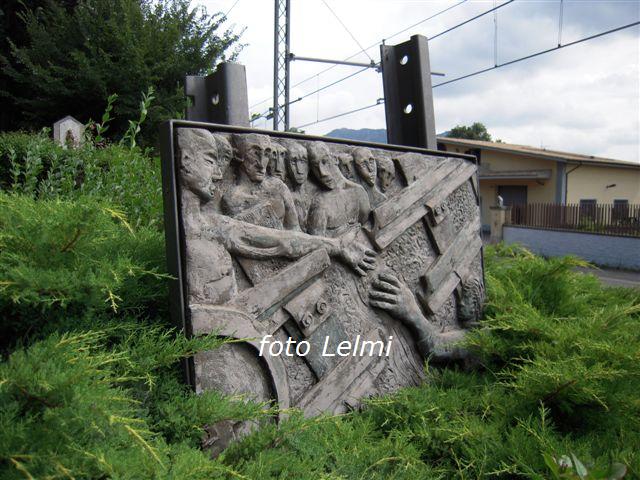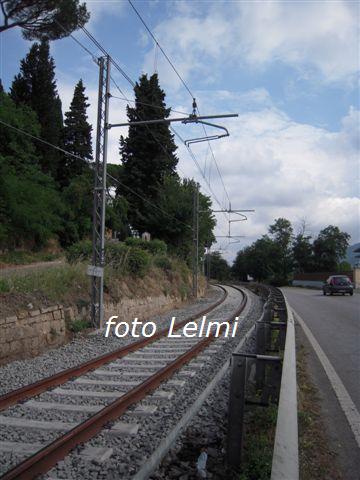
A terrible forgotten misfortune
The Northern Rome Railway line, more similar to a tramway line, then
with slow speed, certainly don't leaves imagine that the November
15 1943 was the subject of a rail disaster of unbelievable proportions:
more one hundred deaths.
After the September 8 1943, began the collapse of the Italian
army, the September 10, Rome became occupied city, everything was
missing, electricity, gas, groceries.
Bombing and strafing night, curfews, raids, seizures of food and things,
violence and retaliation.
Jews fleeing the fierce hunt of the SS,
military disbanded trying to return home, suppression of many train
rides.
The historical context, the climate with which the staff of the railway
had to live, has definitely contributed to the occurrence of this
terrible tragedy.
Here is what told the Gazzetta della Flaminia (Official of the Flaminia)
in December 1988.
The convoy started from Viterbo at 18 and headed to Rome, consisting of
five cars and two locomotives, was full of travelers, stopped at the
Sant'Oreste station.
Many of them had traveled to the province to buy directly from the
farmers, l food stuffs, since evrything was scarce in the city .
To human error, the driver went in the direction of the capital.
A locomotive and four coaches from Rome, stopped at the Rignano Flaminio
station, instead of waiting for the connecting, perhaps due to a
telephone misunderstanding, started again.
In cuve, near the cemetery of Rignano Flaminio, precisely at the level
crossing, the two trains collided.
A roar like an aerial bomb, did run a peasant woman who was taking care
of the hen house, located nearby.
The poor woman at the sight of that incredible spectacle, ran to call
for help in Rignano, running along via Flaminia for about a mile.
When first aid reached, a German military column, aimed at Cassino, was
already providing aid to the injured with some volunteers.
Two locomotives were located to V on the Flaminia, some coaches were
stuck into each other.
The scene was terrible, screams of the wounded trapped in carriages,
dead, blood dripping from the doors of the carriages.
The relentless rain that fell ( 14-15-16 days of November 1943 )
had formed a red river that flowed the wayside.
Cars heading north, carried the wounded to the hospital in Civita
Castellana, those heading south, carried wounded in hospitals in the
capital.
The dead, were placed by the german military, in the churchyard of the
Church of St. Theodora.
At first they were 84.
Then rearranging some human limbs it came to count over 100, the next
day, the smell in the air was nauseating.
The individual episodes were so many, it is said of the disappearance of
a prisoner who was being taken to Rome.
At the end of the war an officer of the police station in Viterbo, questioning the caretaker of the cemetery in Rignano heard that one of
the passengers had the handcuffs, so it was easy to identify the
prisoner and the escort guards.
Moving the
family history Lo Russo.
Riccardo Lo Russo, 42, father of seven children, was traveling on the
train.
Since not returning home, the next day the child with his mother learned
of the death of a spouse, going to the direction of the Northern
Rome Railway.
Once in Rignano Flaminio the next day, his son Giuseppe Lo Russo says
that the churchyard of S.Teodora was full of corpses decapitated,
dismembered.
The father's body was recovered and the funeral took place in Rome.
In the midst of this drama, the human looting had no limits.
Insurance companies sent their "business brokers" to settle for just
pennies the unfortunate relatives, often not having the money for the
funeral, they were content to reimbursement ridiculous.
Another episode disconcerting, as was said, was the presence of a young
man at the scene who struggled to help rescuers to reconstruct the
bodies of the victims.
Noticed by the Germans was searched and found in possession of several
portfolios, was loaded onto a truck to Rome with injuries.
Certainly not made a
happy end.
Giuseppe Lo Russo, as he told himself, to feed her six brothers, had to
go to work at the age of 14 years.
Just a simple plaque at the entrance of the cemetery in Rignano Flaminio,
around the year 2000, remember all those poor dead.
Sergio Maestri (former workshop in Catalan) has pointed out that on-site
there is also a stele erected by the staff of the railway, in memory of
the messenger post (which at the time was traveling in the boot of the
locomotive) and the staff in the train.
questioning the caretaker of the cemetery in Rignano heard that one of
the passengers had the handcuffs, so it was easy to identify the
prisoner and the escort guards.
Moving the
family history Lo Russo.
Riccardo Lo Russo, 42, father of seven children, was traveling on the
train.
Since not returning home, the next day the child with his mother learned
of the death of a spouse, going to the direction of the Northern
Rome Railway.
Once in Rignano Flaminio the next day, his son Giuseppe Lo Russo says
that the churchyard of S.Teodora was full of corpses decapitated,
dismembered.
The father's body was recovered and the funeral took place in Rome.
In the midst of this drama, the human looting had no limits.
Insurance companies sent their "business brokers" to settle for just
pennies the unfortunate relatives, often not having the money for the
funeral, they were content to reimbursement ridiculous.
Another episode disconcerting, as was said, was the presence of a young
man at the scene who struggled to help rescuers to reconstruct the
bodies of the victims.
Noticed by the Germans was searched and found in possession of several
portfolios, was loaded onto a truck to Rome with injuries.
Certainly not made a
happy end.
Giuseppe Lo Russo, as he told himself, to feed her six brothers, had to
go to work at the age of 14 years.
Just a simple plaque at the entrance of the cemetery in Rignano Flaminio,
around the year 2000, remember all those poor dead.
Sergio Maestri (former workshop in Catalan) has pointed out that on-site
there is also a stele erected by the staff of the railway, in memory of
the messenger post (which at the time was traveling in the boot of the
locomotive) and the staff in the train.
Sources:
Russo Giuseppe The "forgot" disaster to Rignano Flaminio La
Gazzetta della Flaminia 12.98
List of dead people in Rignano Flaminio November 15, 1943 at 20
(approximately) of the Northern Rome Nord railway incident (names
provided by the Municipality)
1 Acciaccarelli
Giuseppina
2 Appedisano
Ilario
3 Badamo
Mariano
4 Banci
Aldo
5 Bonelli
Natalina
6 Bordoni
Giuseppe
7
Bronchi Giuseppe
8 Bucciarelli
Filippo
9
Campana Quirino
10
Carpegna Corrado
11 Casadei
Santucci Bruna Sara
12 Catandella
Roberto
13 Caporelli
Annunziata
14 Cencioni
Francesco
15 Celi
Salvatore
16 Corrazzini
Bruno
17 Del
Pelo Angelo
18 Di
Franco Francesco
19 Di
Giovanni Natale
20
Fabbri Ida
21
Ferretti Libero
22
Forti Mario
23 Galadini
Giuseppe
24
Gavazzi Orlando
25 Guarniera
Domenico
26
Guerra Eugenio
27 La
Cava Antonio
28 Lo
Russo Riccardo
29 Lucantoni
Pietro
30 Magliozzi
Dante
31
Mancini Americo
32
Marzi Mario
33
Marzi Sergio
34 Moccia
Aniello
35 Pagliari
Alcide
36 Pedica
Emilio
37 Perilli
Aldo
38 Perilli
Mario
39
Penna America
40
Perugini Renato
41
Pulcini Oliviero
42 Pompili
Girolamo
43 Ranieni
Rosario
44 Rocchegiani
Tripolina
45 Rodighiero
Irido Angelo
46
Romagnoli Giovanni
47 Roberti
Urbano
48
Salvatori Gastone
49 Sagripanti
Torquato
50 Scandurra
Antonio
51 Servucci
Giancarlo
52 Trequattrini
Roberto
53 Urbani
Celso
54
Volpi Antonio
Thank you
for your kind cooperation
the 'Registry
Office of the Municipality of
Rignano Flaminio
From
a story by Arnaldo
Ricci, published in "Campo
de 'Fiori", a monthly
Civita Castellana
IN MEMORY OF VINCENZO
FERRETTI
....Another episode
of self-sacrifice
.....
professional, occurred in
September 1943, when
there was the
collision of two
trains of the
Northern Rome railway, exactly on
the curve
beneath the
cemetery Rignano
Flaminio.
Considered, even
today, by experts in
rail transport, the
most serious incident
of the Italian railways, with more
than
one hundred
killed and two hundred
wounded more or
less serious. Despite the
immediate relief,
with the decisive
help of german troops
that casualty passed
on the via Flaminia
with dozens of
trucks, the final budget
was disastrous!
Obviously, the
nearest hospital was the
Andosilla and
most of the wounded
were brought
in trucks to
Civita.
Who was on the
arrival of injured
saw the Dante's
Inferno! .....

